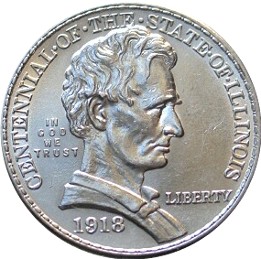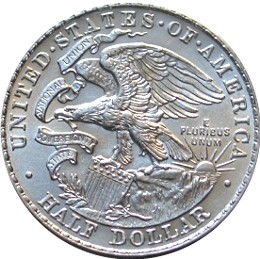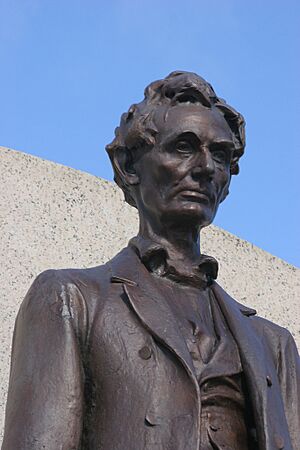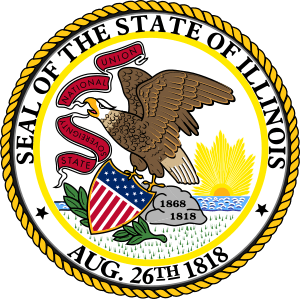Illinois Centennial half dollar facts for kids
| United States | |
| Value | 50 cents (0.50 US dollars) |
|---|---|
| Mass | 12.5 g |
| Diameter | 30.61 mm |
| Thickness | 2.15 mm (0.08 in) |
| Edge | Reeded |
| Composition |
|
| Silver | 0.36169 troy oz |
| Years of minting | 1918 |
| Mintage | 100,058 including 58 pieces for the Assay Commission |
| Mint marks | None, all pieces struck at the Philadelphia Mint without mint mark |
| Obverse | |
 |
|
| Design | Abraham Lincoln |
| Designer | George T. Morgan |
| Design date | 1918 |
| Reverse | |
 |
|
| Design | An eagle, adapted from the Seal of Illinois |
| Designer | John R. Sinnock |
| Design date | 1918 |
The Illinois Centennial half dollar is a special 50-cent coin made by the U.S. Mint in 1918. It was created to celebrate 100 years since Illinois became a state in 1818.
The front side, called the obverse, shows Abraham Lincoln. This design was made by Chief Engraver George T. Morgan. The back side, or reverse, features an eagle. This design was created by John R. Sinnock, who was Morgan's assistant. The eagle design is based on the Seal of Illinois.
These coins were sold to the public for $1 each. This was twice their face value (50 cents). The extra money helped pay for Illinois' centennial celebrations. It also helped people affected by World War I. Today, these coins are worth hundreds of dollars to collectors.
Why the Coin Was Made
Illinois wanted a special coin to celebrate its 100th birthday. The state joined the Union in 1818. So, in 1918, a bill was introduced in Congress to create this commemorative coin.
Loren E. Wheeler, a representative from Illinois, introduced the bill. He explained that the coins would be sold during the state's celebrations. The money raised would help pay for these events.
The U.S. Treasury Secretary and Mint Director had no problem with the idea. However, they worried that special coins sometimes didn't sell well. They feared many might be returned to the Mint. To avoid this, Illinois agreed to buy all 100,000 coins directly. This meant the government wouldn't lose money. Illinois also agreed to pay for the coin's dies (the metal stamps used to make coins).
The bill passed easily in both the House of Representatives and the Senate. President Woodrow Wilson signed it into law on June 1, 1918. This made the Illinois Centennial half dollar official.
Coin Design and Artists

The designs for the coin were made at the Philadelphia Mint. The front of the coin, the obverse, shows Abraham Lincoln. He is shown without a beard, as he looked when he lived in Illinois. Lincoln was chosen because he is Illinois' most famous resident.
This design was created by George T. Morgan, the Chief Engraver. He based it on a photo of a statue of Lincoln. This statue was made by Andrew O'Connor. The obverse also includes the words LIBERTY, IN GOD WE TRUST, and the centennial dates.
The back of the coin, the reverse, was designed by John R. Sinnock. He later became the Chief Engraver himself. His design is based on the Seal of Illinois. It shows an eagle sitting on a rock. Behind the eagle, the sun is rising.

The eagle holds a scroll in its beak with the Illinois state motto: STATE SOVEREIGNTY, NATIONAL UNION. It also holds the U.S. shield. There is an olive branch, a symbol of peace. Some experts think arrows (symbols of war) were left out because World War I was still happening. The reverse also has the words UNITED STATES OF AMERICA, E PLURIBUS UNUM (meaning "out of many, one"), and HALF DOLLAR.
The Treasury Secretary, William G. McAdoo, first asked for some changes. He wanted the Illinois motto removed from the scroll. But the Illinois motto was kept on the coin.
Coin experts have praised the design. They say Morgan's Lincoln is one of his best works. They also consider Sinnock's eagle design to be excellent. The coin's edge has small beads instead of typical ridges, which collectors find appealing.
Making and Selling the Coin
The people of Illinois will be pardoned if they feel a little "chesty" over their Illinois Centennial half dollar. Besides being a very handsome piece of money, it is the first of its class to be issued by the government. None of our previous souvenir coins has been for the purpose of commemorating an occasion, event or undertaking that was confined entirely by the boundaries of a single state. It is distinctly an Illinois coin.
A total of 100,058 Illinois Centennial half dollars were made. They were all struck at the Philadelphia Mint in August 1918. A few extra coins were made for the annual Assay Commission. This group checks the quality of U.S. coins.
The coins were not sold in special packaging. Some were used in badges for the Illinois Centennial Commission. The centennial commission sold the coins to local groups in Illinois. They were sold for $1 each, with the extra 50 cents going to local celebrations or war relief efforts.
Some coins were sold by the Springfield Chamber of Commerce. A bank held 30,000 coins for 15 years. They sold them in 1933 during a "Bank Holiday" for a bit more than their face value. This briefly made many coins available.
In 1980, uncirculated coins (coins that were never used in everyday buying and selling) were worth about $300. Today, an Illinois Centennial half dollar can be worth between $130 and $685. The exact value depends on its condition. A very rare and perfect coin sold for $7,040 at an auction in 2014.

